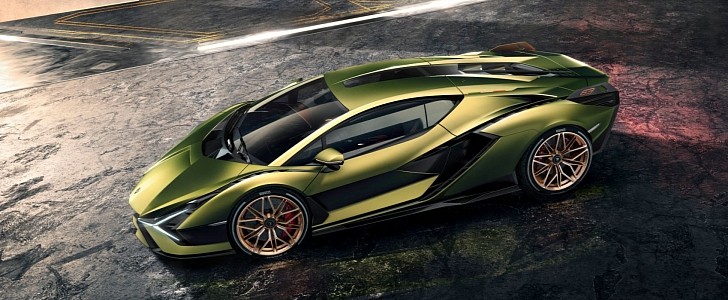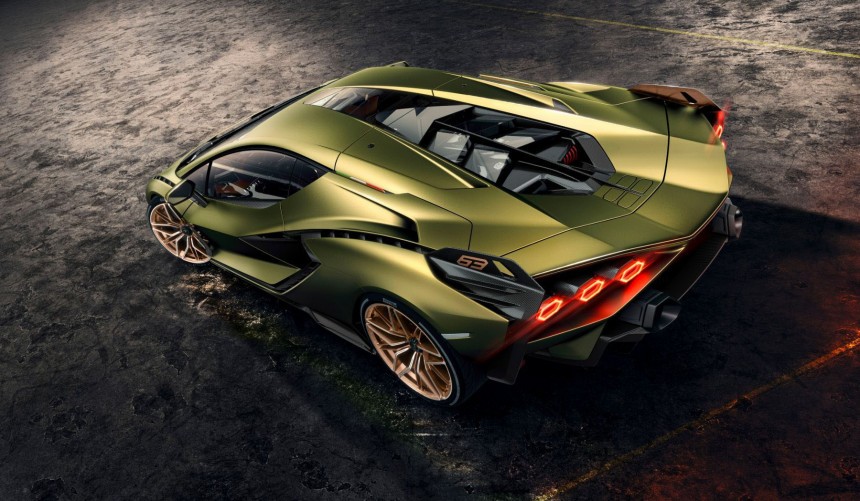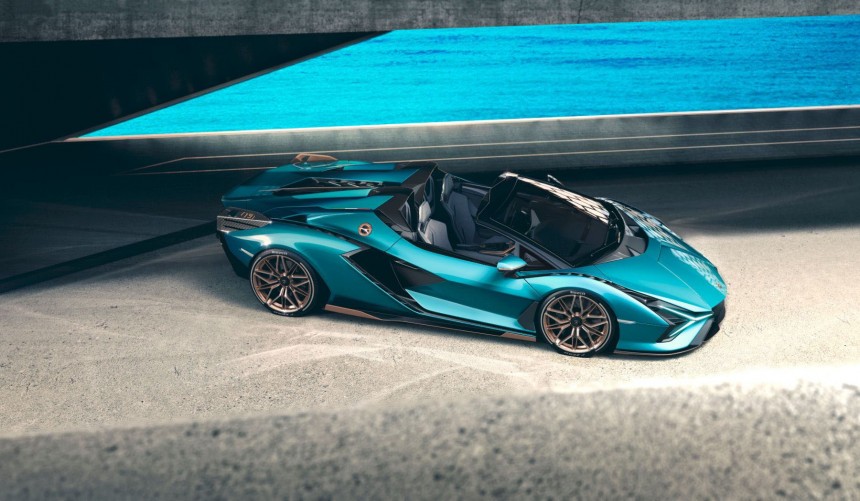The Italian manufacturer has been producing some of the most sought-after exotic cars of all time that highlight cutting-edge technologies and powerful engines. Their first endeavor into hybrid-propulsion is the Sian, a mid-engine hypercar that utilizes an innovative supercapacitor array instead of a traditional battery pack.
The Lamborghini Sian FKP 37 was unveiled at an online-broadcasted event on 3 September 2019. It is based on the Aventador and gets its name from a Bolognese word which means ‘flash’ or ‘lightening’.
The exterior design harks back to the work of legendary Italian designer Marcello Gandini, the man behind some of the most beautiful Lamborghinis of all time like the Miura, Countach or Diablo.
Powering the gorgeous Sian is Lamborghini’s first hybrid powertrain and, as you would expect, there is nothing conventional about it. It uses the same 6.5-liter L539 V12 engine as the Aventador SVJ but it produces 774 hp (577 kW; 785 PS) thanks to the addition of titanium intake valves, an updated ECU and a new exhaust system.
The engine is aided by a 34 hp (25 kW; 34 PS) electric motor that is built into the seven-speed ISR semi-automatic gearbox. It can support low-speed maneuvers such as parking and reversing or it can provide aid to the massive V12 engine.
It also reduces the amount of torque that hits the gears, which results in a smoother delivery of power and better traction, eliminating any form of momentum loss while shifting gears.
The combine output of the electric motor and mid-mounted V12 is a massive 807 hp (602 kW; 818 PS) which allows the car to accelerate from 0 to 100 kph (0-62mph) in 2.8 seconds, a figure that is in the same territory with all-electric speed-demons such as the Tesla Model S Performance or Porsche Taycan.
Energy for the 48-volt motor is provided by a supercapacitor array that can charge and release energy much faster than a battery pack and is able to withstand a higher number of charge/discharge cycles without degradation.
It can also store three times more energy than a battery pack with the same capacity and uses the car’s advanced regenerative braking system to generate it, allowing the Sian to break free of being plugged in for a full recharge.
Another key advantage it provides is weight-saving. Because of the fast discharge capabilities, the system can be much smaller than a battery pack while delivering the same amount of power.
The motor/generator and supercapacitor system inside the Sian’s transmission only weighs 34 kg (75 lbs.) but deliver the same power output as a 602kW battery.
The downside for supercapacitors is the poor energy storage for a prolonged amount of time. The energy stored dissipates quickly over time and drivers might not be able to use the added power when starting up the Sian after a week-long break.
Thankfully, owners can easily survive with the 700+ hp V12 when backing the car out of a garage or getting that first practice lap out of the way on a track day. Brake hard several times and the regenerative system will fully recharge the supercapacitors.
The Lamborghini Sian is being manufactured in 63 units, which have already been sold for around $3.6 million each. An open top roadster version was revealed In July 2020 with a limited production of 19 units that feature 3D printed carbon fiber rear vents on which customers can add their initials.
The exterior design harks back to the work of legendary Italian designer Marcello Gandini, the man behind some of the most beautiful Lamborghinis of all time like the Miura, Countach or Diablo.
Powering the gorgeous Sian is Lamborghini’s first hybrid powertrain and, as you would expect, there is nothing conventional about it. It uses the same 6.5-liter L539 V12 engine as the Aventador SVJ but it produces 774 hp (577 kW; 785 PS) thanks to the addition of titanium intake valves, an updated ECU and a new exhaust system.
It also reduces the amount of torque that hits the gears, which results in a smoother delivery of power and better traction, eliminating any form of momentum loss while shifting gears.
The combine output of the electric motor and mid-mounted V12 is a massive 807 hp (602 kW; 818 PS) which allows the car to accelerate from 0 to 100 kph (0-62mph) in 2.8 seconds, a figure that is in the same territory with all-electric speed-demons such as the Tesla Model S Performance or Porsche Taycan.
Energy for the 48-volt motor is provided by a supercapacitor array that can charge and release energy much faster than a battery pack and is able to withstand a higher number of charge/discharge cycles without degradation.
It can also store three times more energy than a battery pack with the same capacity and uses the car’s advanced regenerative braking system to generate it, allowing the Sian to break free of being plugged in for a full recharge.
Another key advantage it provides is weight-saving. Because of the fast discharge capabilities, the system can be much smaller than a battery pack while delivering the same amount of power.
The downside for supercapacitors is the poor energy storage for a prolonged amount of time. The energy stored dissipates quickly over time and drivers might not be able to use the added power when starting up the Sian after a week-long break.
Thankfully, owners can easily survive with the 700+ hp V12 when backing the car out of a garage or getting that first practice lap out of the way on a track day. Brake hard several times and the regenerative system will fully recharge the supercapacitors.
The Lamborghini Sian is being manufactured in 63 units, which have already been sold for around $3.6 million each. An open top roadster version was revealed In July 2020 with a limited production of 19 units that feature 3D printed carbon fiber rear vents on which customers can add their initials.









